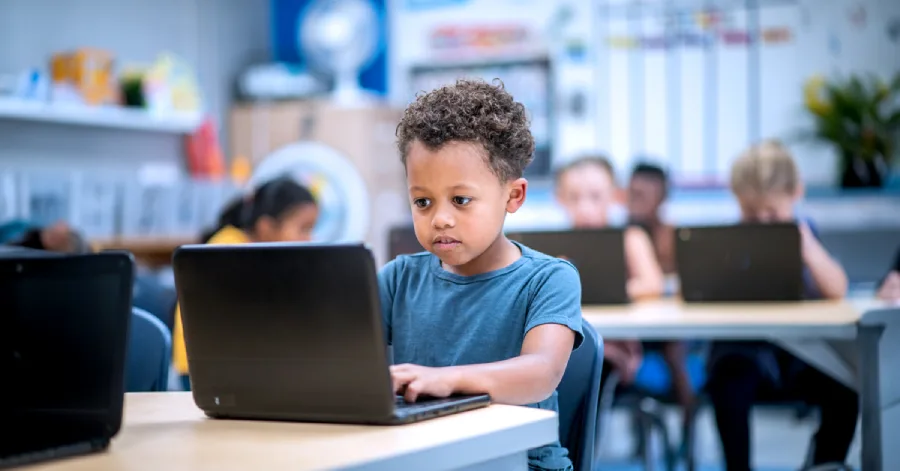From Chalkboards to Chatbots — The Future of Learning Unveiled
- Published on: December 17, 2024
- |
- Updated on: April 29, 2025
- |
- Reading Time: 5 mins
- |
-
Views
- |
A classroom is a dynamic environment. It consists of roles and relationships that are critical to creating a space where learning thrives. When technology respects this dynamic, it becomes a powerful ally. Technology in education is most impactful when it works alongside teachers and students, enhancing their efforts rather than overshadowing them.
Dan Cogan-Drew, Chief Academic Officer at Newsela, emphasizes this idea by highlighting how Newsela adapts content to different reading levels, empowering both teachers and students. This approach keeps everyone engaged and shows that technology works best when it supports teaching instead of replacing it. For example, personalized learning tools let students move at their own pace when they learn something early and share it with their teachers.
Creating Harmony Between Technology and Classroom Dynamics
But it isn’t always smooth sailing. Teachers often struggle to use these tools in group activities, not knowing how to balance individual learning with classroom lessons. It can be difficult to adjust teaching methods to ensure everyone is progressing at their own pace while maintaining focus on the class as a whole.
Additionally, when software labels students as “below grade level” or places them in rigid categories, it can limit their potential. These labels don’t account for a student’s personal interests or strengths. For example, a student labeled as a “seventh-grade reader” might be an expert on topics like gardening or baseball and capable of reading far beyond the grade level the label suggests.
Such examples highlight the need for balance. Technology is most useful when it helps with things like offering different content or handling routine tasks, without replacing the personal and creative parts of teaching.
The goal should be to support what’s already happening in the classroom. If a tool helps with lesson prep, provides engaging content, or tracks progress without adding extra work, it’s a win. But suppose AI tries to replace tasks that require human interference – like understanding students’ strengths or even cultivating a sense of belonging. In that case, it can definitely interfere with the natural flow of classroom learning.
AI in Education: A Collaborative Path to Better Learning
To truly transform learning, AI must be used with purpose, solving real challenges rather than just being a trend. Schools should adopt AI to address specific problems, not just because it’s popular. For example, research from the University of Michigan highlights how teachers use AI in two ways: one, to seek input and the other to seek output. Teachers who use AI to come up with new teaching strategies and assessment methods find it more effective than using AI for repetitive tasks like generating assignments. This shows that AI can be a valuable tool in helping teachers address challenges and not just automate simple tasks. The idea is that it should support problem-solving, not replace basic teaching duties.
EdTech companies need to ensure that AI helps, not hinders, creativity and critical thinking. AI can help students gain confidence by offering structure and feedback on tasks like writing. However, teachers are still needed to encourage deeper creativity and critical thinking. AI can assist with basic skills, but it can’t replace guidance provided by teachers. AI and teachers should work together to improve learning.
Personalized Learning Needs Personalized Assessments
To truly reflect personalized learning, assessments need to move beyond traditional methods. While assessments work well for subjects like math and literacy, where progress can follow clear paths, they struggle to capture a student’s understanding in more complex areas such as background knowledge and interdisciplinary skills. Some tools do well at mapping concepts, but other subjects need more flexible approaches.
Teachers often use discussions, presentations, and written work to assess students, but these can be hard to scale. Technology offers the potential to create more reliable assessments that capture different ways students express their learning, but this requires new tools and a shift in how we approach assessments.
It becomes increasingly important to give teachers useful data without adding to their workload to improve assessments. Most assessments today are summative, giving a final score with little immediate feedback. Formative assessments, on the other hand, provide ongoing insights that help teachers adjust lessons as needed. By focusing on the end goal and using smaller checks along the way, teachers can guide students toward mastery. Technology can make formative assessments easier by automating parts of the process, and giving teachers quick, specific feedback on student progress without extra work.
AI can also make formative assessments more adaptive and responsive. Students don’t always get enough chances to express themselves during lessons. AI can help by automating assessments for things like writing or speaking. This gives quick feedback and useful insights, helping teachers adjust their approach to support each student’s progress.
Building Schools That Can Keep Pace With AI’s Evolution
AI is evolving quickly, and one main conversation that’s often overlooked in education is how fast this change is happening. In the next five years, AI is expected to surpass human abilities in many areas, which will lead to big changes in how schools work. To prepare, education leaders need to focus on building flexible systems that can keep up with these changes.
For K-12 district leaders unsure about adopting AI, the advice is to start small and test carefully. Choose experienced teachers to try out AI tools on a small scale. They can test, gather feedback, and adjust before expanding. It’s important not to just copy what other districts are doing, as each school has its own needs and challenges. AI tools should be evaluated based on what works best for each school.
In addition to testing new technologies, school leaders should focus on creating flexible systems that can adapt to change. As AI evolves, schools need to be ready to adjust. This means supporting teachers, staff, and administrators while also embracing new technology. By promoting adaptability, districts can make sure AI improves education without causing disruption. All we can say is, the future of education can be both dynamic and effective.
FAQs
Student data protection requires implementing robust encryption, obtaining explicit consent for data collection, establishing clear data retention policies, and ensuring compliance with education privacy regulations like FERPA. Consider creating anonymized student profiles and implementing role-based access controls for different stakeholders.
Develop a comprehensive onboarding program that includes initial training, ongoing coaching, and peer learning communities. Create easily accessible resources like video tutorials, best practice guides, and troubleshooting documentation. Establish a dedicated support team familiar with educational contexts. Consider offering specialized training for different roles (teachers, administrators, IT staff).
Focus on developing flexible content frameworks that can accommodate regional curriculum standards and cultural nuances. Consider creating region-specific training datasets for AI models. Partner with local educators to validate content relevance. Implement language support that goes beyond simple translation to include cultural context and local educational practices.
Regular auditing of AI algorithms for bias in content recommendations and assessment scoring is essential. Develop diverse training datasets that represent various demographics and learning styles. Create features that support multiple learning modalities. Include educators from diverse backgrounds in the development and testing process. Implement regular feedback loops to identify and address any emerging bias patterns.

Get In Touch
Reach out to our team with your question and our representatives will get back to you within 24 working hours.


